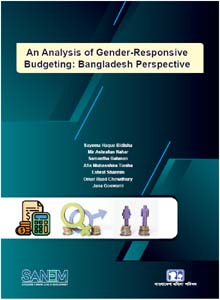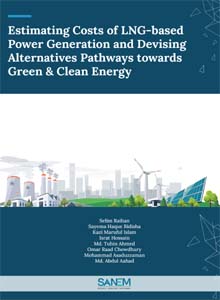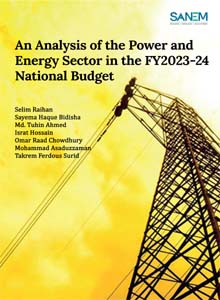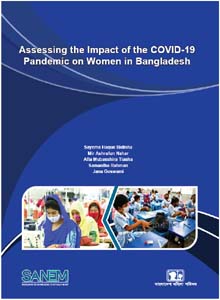
An Analysis of Gender-Responsive Budgeting: Bangladesh Perspective
 Citation: Bidisha, S. H., Nahar, M. A., Rahman, S., Tiasha, A. M., Sharmin, E., Chowdhury, O. R., & Goswami, J. (2023). An Analysis of Gender-Responsive Budgeting: Bangladesh Perspective. SANEM Publications, Dhaka, Bangladesh.
Citation: Bidisha, S. H., Nahar, M. A., Rahman, S., Tiasha, A. M., Sharmin, E., Chowdhury, O. R., & Goswami, J. (2023). An Analysis of Gender-Responsive Budgeting: Bangladesh Perspective. SANEM Publications, Dhaka, Bangladesh.
Gender-responsive budgeting (GRB) is a targeted budgetary instrument implemented into multiple developing countries’ fiscal plans. GRB ensures that policy prescriptions to address gender inequality are translated into outputs by binding them to budgetary allocations. Gender-responsive budgeting (GRB) was initially put forward during the Fourth World Conference on Women in Beijing, China, in 1995.
The primary objective of this study is to illustrate gender-responsive budgeting from Bangladesh’s perspective and to compare it to budgets from previous fiscal years and other countries. Developing countries employ gender-responsive budgeting (GRB) as a financial strategy to address gender inequality by matching budgetary provisions with policy initiatives. It goes beyond women-centric programmes by openly devoting budgetary funds towards the advancement of women and by assessing the gendered effects of those funds. In terms of tax and fine revenue generation, GRB also evaluates the differences between their impacts on men and women. The IMF report “Women, Work, and the Economy: Macroeconomic Gains from Gender Equity” emphasised the necessity for gender equality for economic growth by highlighting the economic losses brought on by gender-based discrimination in the labour market. The best method to deal with these problems is to incorporate gender-responsive budgeting (GRB) into national budgets. Particularly when it comes to the informal economy and carer responsibilities, which are frequently overlooked in government budgets, gender inequalities in practical requirements and the inadequate representation of women in public life can result in policies that unintentionally perpetuate inequality.
Moreover, gender-responsive budgeting is a major concern globally as well as in our country. It is a strategic approach that involves working thoroughly to integrate gender perspectives at various stages of the budget plan, including Gender Budget Analysis, modifications and adjustments to budgets and policies, Gender budget analysis should be systematically incorporated into planning and budgeting. In Articles 19, 27, 28, and 29 of the People’s Republic of Bangladesh constitution, women are guaranteed equal rights and privileges. All citizens are guaranteed equality of opportunity under Article 19(1), and Article 28(1) states that the State is prohibited from discriminating against residents based on their religion, race, caste, sex, or place of birth. The enactment of measures encouraging the advancement of women is accelerated by Article 28(4). Bangladesh is a signatory to almost all international agreements and accords on women’s development, notwithstanding the constitutional apprehension.
The purpose of this study is to provide a gender-sensitive analysis of Bangladesh’s development spending over the previous five fiscal years, from FY 2017–18 to FY 2021–22. Projects supported by the Bangladeshi government and development organisations are included in the development expenditure. For this study, we have chosen a list of 42 ministries and divisions that are examined annually as part of the Gender Budget Report developed by the Ministry of Finance. With the support of both the government and civil society organisations, the implementation of GRB in Bangladesh has gained momentum over time. Although Bangladesh has made admirable progress in adopting gender-responsive budgeting, there is still work to be done. Bangladesh has recognised the necessity of resolving gender inequities and supporting women’s rights as key parts of sustainable development. Bangladesh can deepen its commitment to gender equality, women’s empowerment, and inclusive development by resolving outstanding issues and building on its current accomplishments. Moreover, a higher level of gender equality promotes the idea of equal pay for work of equal value, works to stop discrimination, combats pay discrimination and offers financial support and incentives to people, families, and communities at large in order to encourage a shift in or elimination of discriminatory attitudes. The officials involved with the formulation of the budget at the line ministry level should undergo continuous instruction on gender budgeting. Gender budgeting should take into account global best practices (such as gender audits, analyses of the ex-ante and ex-post effects of policies on gender, needs assessments, baseline analyses, and the consideration of gender when allocating resources, etc.).



